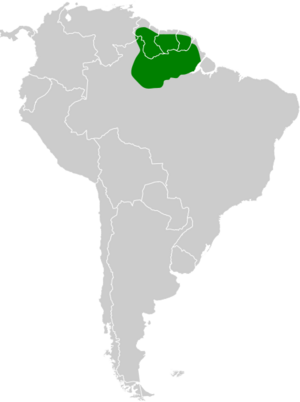Guianan gnatcatcher facts for kids
Quick facts for kids Guianan gnatcatcher |
|
|---|---|
| Conservation status | |
| Scientific classification | |
| Genus: |
Polioptila
|
| Species: |
guianensis
|
 |
|
The Guianan gnatcatcher (Polioptila guianensis) is a small, active bird found in South America. It belongs to the gnatcatcher family, Polioptilidae. You can find this bird in countries like Brazil, French Guiana, Guyana, Suriname, and Venezuela.
Contents
About the Guianan Gnatcatcher
The Guianan gnatcatcher is considered a single species, meaning it doesn't have different types or subspecies. Until recently, some other gnatcatchers were thought to be the same species. However, since 2019, birds like the Rio Negro gnatcatcher and the Para gnatcatcher are now seen as their own separate species. Other close relatives include the Inambari gnatcatcher and the Iquitos gnatcatcher.
What Does It Look Like?
The Guianan gnatcatcher is a small bird, about 10 to 11 cm (3.9 to 4.3 in) long. That's about the length of a small smartphone! It weighs around 5 to 7 g (0.18 to 0.25 oz), which is lighter than a single grape.
Male Guianan gnatcatchers have a bluish-gray head, back, and chest. They have a broken white ring around their eyes. The feathers in the middle of their tail are black, while the two outer tail feathers are white. Their throat and belly are white.
Female gnatcatchers look similar to males but are a lighter gray color. They also have a white stripe above their eye, called a supercilium.
Where Does It Live?
The Guianan gnatcatcher lives in an area called the Guianas and nearby parts of Brazil. Its home range stretches south to the Amazon River. It might also live further west in eastern Venezuela.
These birds prefer to live in humid forests. They can be found at the edges of thick primary forest (forests that haven't been disturbed much). They also live in savanna forests and dryland forests. They often stay in the upper parts of the trees, known as the canopy.
How It Behaves
Feeding Habits
Scientists don't have a lot of detailed information about what the Guianan gnatcatcher eats. However, like other gnatcatchers, it is believed to eat arthropods. Arthropods are small creatures like insects and spiders.
These birds are very active when they look for food. They often join "mixed-species flocks." This means they fly and forage with groups of different kinds of birds. This can help them find food and stay safe from predators.
Reproduction and Life Cycle
Not much is known about how the Guianan gnatcatcher raises its young. We don't have many details about their breeding habits. However, one observation was made in French Guiana on November 27, 1984. A male Guianan gnatcatcher was seen feeding a young bird that had just left the nest. This suggests they breed around that time of year.
What Does It Sound Like?
The song of the Guianan gnatcatcher is described as "fairly simple." It consists of repeated high-pitched notes. You can listen to its song online [1].
Conservation Status
The IUCN (International Union for Conservation of Nature) is an organization that assesses how endangered different species are. The Guianan gnatcatcher has not been assessed by the IUCN as a separate species yet. Instead, it was part of a larger group of gnatcatchers that were assessed before 2019.
That larger group was listed as "Least Concern." This means they were not considered to be at serious risk of disappearing. The main area where this species lives, the Guianan moist forest, is also not thought to be in serious danger. This is good news for the Guianan gnatcatcher's future.


